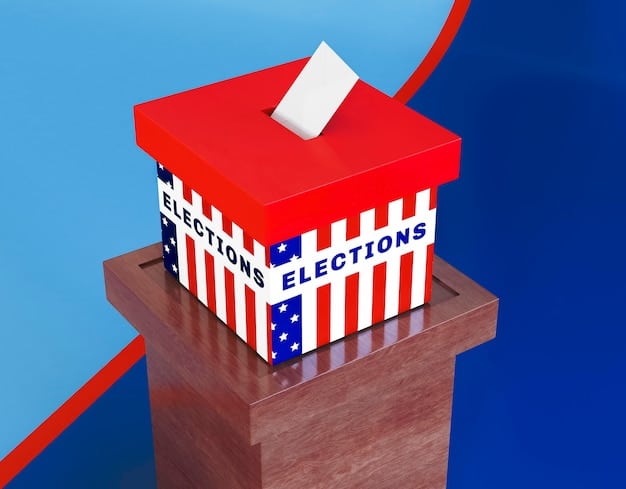Campaign Finance Amendments: 2026 Midterms Impact

Proposed constitutional amendments on campaign finance could significantly reshape the 2026 midterm elections by altering fundraising dynamics, influencing candidate strategies, and potentially shifting the balance of power between parties and interest groups.
The potential impact of proposed constitutional amendments on campaign finance is a hot topic as we look toward the 2026 midterm elections. How these amendments could change the political landscape is a crucial question, and this article will delve into the possible ramifications. Understanding the **how will the proposed constitutional amendments on campaign finance impact the 2026 midterms** is essential for anyone interested in the future of US politics.
Understanding the Proposed Amendments
The landscape of campaign finance is constantly evolving, and proposed constitutional amendments seek to address various perceived shortcomings and inequities. These amendments could dramatically alter how campaigns are funded and how much influence money has in elections. Understanding the specifics of these proposed changes is critical to assessing their potential impact.
Several key areas are typically targeted by such amendments, including limits on individual and corporate contributions, regulations on Political Action Committees (PACs) and Super PACs, and measures to increase transparency in campaign spending. Let’s examine what’s at stake.
Contribution Limits and Individual Donors
One central debate revolves around the size and scope of individual contributions. Proposed amendments often aim to either increase or decrease these limits, with proponents on both sides arguing for their respective positions. Lowering limits aims to reduce the influence of wealthy donors, while raising them is advocated to allow candidates to reach more voters.
PACs, Super PACs, and Dark Money
PACs and Super PACs play a significant role in campaign finance and these independent expenditure groups may be in for new rules. “Dark money,” or funds from undisclosed sources, is yet another contentious area and any changes here could have a dramatic effect.
- Restrictions on Independent Expenditures: Some amendments seek to limit the amount of money that can be spent independently of a candidate’s campaign.
- Increased Disclosure Requirements: These amendments aim to shed light on the sources of funding for political campaigns.
- Redefining “Coordination”: Amendments may clarify what constitutes illegal coordination between campaigns and outside groups.

These measures, if enacted, could reshape the financial playing field, potentially leveling the playing field for lesser-known candidates. However, opponents argue that such restrictions infringe on free speech rights and could hinder legitimate political expression.
Historical Context of Campaign Finance Reform
To truly grasp the potential impact of these proposed changes, it’s essential to understand the historical trajectory of campaign finance reform in the United States. Landmark legislation and Supreme Court decisions have sculpted this landscape, and the proposed amendments represent the latest chapter in this ongoing narrative.
From the Tillman Act of 1907 to the Bipartisan Campaign Reform Act of 2002 (McCain-Feingold), the US has a history of attempting to regulate campaign contributions and spending. Court cases like Buckley v. Valeo (1976) and Citizens United v. FEC (2010) have had seismic effects on the rules. The proposed amendments could be seen as a reaction to and an attempt to correct what some view as negative consequences of those court decisions.
Key Legislation and Supreme Court Cases
Understanding the legal precedents is vital to understanding the potential consequences of the new amendments to campaign finance law. Let’s take a brief look at some leading cases and legislation that define campaign finance regulation in the United States.
The First Amendment vs. Campaign Finance Regulations
The crux of many legal battles over campaign finance revolves around the tension between the First Amendment’s guarantee of free speech and the government’s interest in preventing corruption or the appearance thereof.
- Buckley v. Valeo (1976): This case established that while campaign contributions can be limited, independent expenditures are protected free speech.
- Citizens United v. FEC (2010): This ruling held that corporations and unions have the same First Amendment rights as individuals, leading to the rise of Super PACs.
- McCutcheon v. FEC (2014): Removed limits on the total amount an individual can donate to all federal candidates, parties, and political committees combined.
These Supreme Court decisions have significantly reshaped the landscape of campaign finance, leading to increased spending and the rise of outside groups. The proposed amendments aim to address some of the perceived consequences of these rulings.
Potential Impact on Fundraising Strategies
The impact of potential constitutional amendments on fundraising strategies for candidates and parties will be crucial. How campaigns adapt to these changes will significantly influence their ability to compete effectively in the 2026 midterm elections.
If amendments restrict large individual or corporate donations, campaigns may need to rely more on grassroots fundraising and small-dollar donors. Transparency measures could also force campaigns to disclose their funding sources more openly, affecting their ability to attract certain types of donors. Let’s see how these things work.
Reliance on Small-Dollar Donors
With a reduction in the limit on individual contributions, candidates could focus on attracting small-dollar donors, a strategy that has gained prominence in recent years.
The Rise of Grassroots Funding
In the era of tight campaign finance, grassroots funding may become the only strategy for candidates wishing to win elected office. Such funding may arise from Political Actions Committees (PACs) or individual donations.
- Online Fundraising Platforms: Platforms like ActBlue and WinRed have become essential tools for campaigns seeking to raise money online.
- Social Media Engagement: Campaigns are leveraging social media to reach potential donors and encourage small contributions.
- Subscription Models: Some campaigns have adopted subscription models, where donors commit to recurring monthly contributions.

However, relying on small-dollar donors also presents challenges, such as the need to reach a larger number of people and the potential for increased administrative costs. Campaigns must effectively manage these challenges to succeed in this new landscape.
Impact on Candidate Messaging and Campaign Discourse
Beyond fundraising, the proposed amendments could also impact candidate messaging and the overall tone of political discourse. Restrictions on certain types of advertising or spending could force candidates to adopt different strategies for reaching voters and engaging in policy debates.
For instance, if amendments limit the use of attack ads or require greater transparency in political advertising, campaigns may need to focus more on positive messaging and substantive policy discussions. Altered messaging could shift negative partisanship.
Shift Towards Positive Messaging
A focus on positive messaging and communication can be an effective way to get a candidate elected. Here are some ways campaigns may adapt to tighter campaign finance law.
Focus on Policy and Issues
Restrictions on attack ads could lead to more constructive dialogue on policy issues. Candidates would have to communicate their positions more clearly to stand out.
- Debates and Town Halls: Candidates may participate in more debates and town halls to engage with voters directly.
- Policy Papers and White Papers: Campaigns may release detailed policy papers to demonstrate their expertise on key issues.
- Social Media Q&As: Candidates may use social media platforms to host Q&A sessions with voters, addressing their concerns and policy questions.
However, it is also possible that campaigns could find new ways to circumvent the restrictions, engaging in coded language or indirect attacks that skirt the letter of the law. The actual impact on candidate messaging will depend on how strictly the amendments are enforced.
Potential Winners and Losers
The proposed amendments are likely to create winners and losers, depending on their specific provisions and how they are implemented. Some candidates, parties, or interest groups may benefit from the changes, while others may find themselves at a disadvantage.
For example, if amendments favor small-dollar donors, candidates with strong grassroots support may have an advantage. Alternatively, if amendments restrict the influence of outside groups, established parties with broader networks may benefit.
Partisan Effects
The changes may favor one party over another giving one side an advantage in upcoming elections. The influence of large donors could sway election results, and if large donors are restricted then the opposite could also be true.
Impact on Third Parties
Third parties and independent candidates often struggle to compete with the major parties due to lack of funds. Amendments may level the playing field, allowing them to run more competitive campaigns.
- Access to Public Funding: Some amendments may provide third parties with greater access to public funding, helping them to compete with the major parties.
- Lower Barriers to Entry: Restrictions on large donors or outside groups may make it easier for third parties to gain traction and build support.
- Increased Media Attention: A more competitive landscape could lead to increased media attention for third-party candidates and their ideas.
Ultimately, the impact on winners and losers will depend on the specific details of the amendments and how effectively different actors adapt to the new rules of the game.
Navigating Uncertainty and Future Outlook
As the 2026 midterm elections approach, uncertainty surrounding the proposed amendments adds a layer of complexity to the political landscape. Campaigns, parties, and interest groups must carefully navigate this uncertainty, preparing for various possible outcomes and adapting their strategies accordingly. There may be more hurdles to cross before these policies are implemented.
This requires a combination of strategic planning, flexibility, and a willingness to experiment with new approaches. Close monitoring of legal challenges and regulatory developments is also essential.
Strategic Planning and Adaptability
Campaigns must plan for multiple scenarios and be ready to pivot quickly as the legal and regulatory landscape evolves. A high degree of adaptability is paramount. Strategic campaigns must also be ethical and follow current campaign finance law.
Legal Challenges and Court Rulings
The amendments will likely face legal challenges, and court rulings could significantly alter their impact. Litigation may have significant effects on new policies
- Ongoing Monitoring: Campaigns and parties must closely monitor legal challenges and court rulings, adjusting their strategies as needed.
- Scenario Planning: Organizations should develop contingency plans for various legal outcomes, ensuring they are prepared for any potential challenges to the amendments.
- Legal Expertise: Campaigns should consult with legal experts to understand the implications of the amendments and how to comply with any new regulations.
The only certainty is that the road ahead will be filled with challenges and adaptations. How campaigns and other political actors navigate this uncertainty will significantly impact their success in the 2026 midterm elections and beyond.
| Key Aspect | Brief Description |
|---|---|
| 💰 Contribution Limits | Amendments may alter limits on individual and corporate donations. |
| 📢 Messaging & Discourse | Campaigns may shift towards positive, policy-focused communication. |
| 🤝 Grassroots Funding | Increased reliance on small donations and online fundraising platforms. |
| ⚖️ Legal Challenges | Potential for legal battles affecting implementation and impact. |
FAQ
▼
Constitutional amendments on campaign finance aim to modify the rules governing how political campaigns are funded, potentially impacting contribution limits and transparency.
▼
These amendments may change election results by influencing fundraising capabilities, messaging strategies, and the overall dynamics between candidates and parties.
▼
Small-dollar donors may gain prominence, particularly if amendments restrict large contributions, increasing the importance of grassroots fundraising efforts for campaigns.
▼
The key debates revolve around the balance between free speech rights, preventing corruption, and ensuring fair and equal access to political participation.
▼
Campaigns can adapt by focusing on grassroots fundraising, positive messaging, and policy-focused communication, while closely monitoring legal challenges and regulatory developments.
Conclusion
The proposed constitutional amendments represent a pivotal moment in the ongoing debate over money in politics. The way forward requires careful consideration, strategic adaptation, and a commitment to upholding the principles of democracy in the face of evolving challenges.





